Southwestern interior design draws inspiration from the rugged beauty of desert landscapes, Indigenous art, and Spanish colonial architecture. Key elements include warm, earthy color palettes—think terracotta, sand, and sage green—balanced with vibrant accents like turquoise or coral. Textures play a crucial role: plastered adobe walls, rustic wood beams (vigas), handwoven textiles, and natural stone create depth and authenticity. Iconic motifs such as Navajo or Zapotec patterns appear in rugs, pillows, and wall art, while leather, wrought iron, and handcrafted pottery serve as distinctive accessories. Flooring options like saltillo tiles or wide-plank wood anchor the space, and strategic lighting—lanterns or wrought-iron sconces—adds both function and ambiance. Integrating live greenery (succulents, cacti) and outdoor living elements (patios, courtyards) blurs the line between inside and out. Altogether, these components form a cohesive style that feels warm, inviting, and timeless.
1. Warm Earthy Color Palette
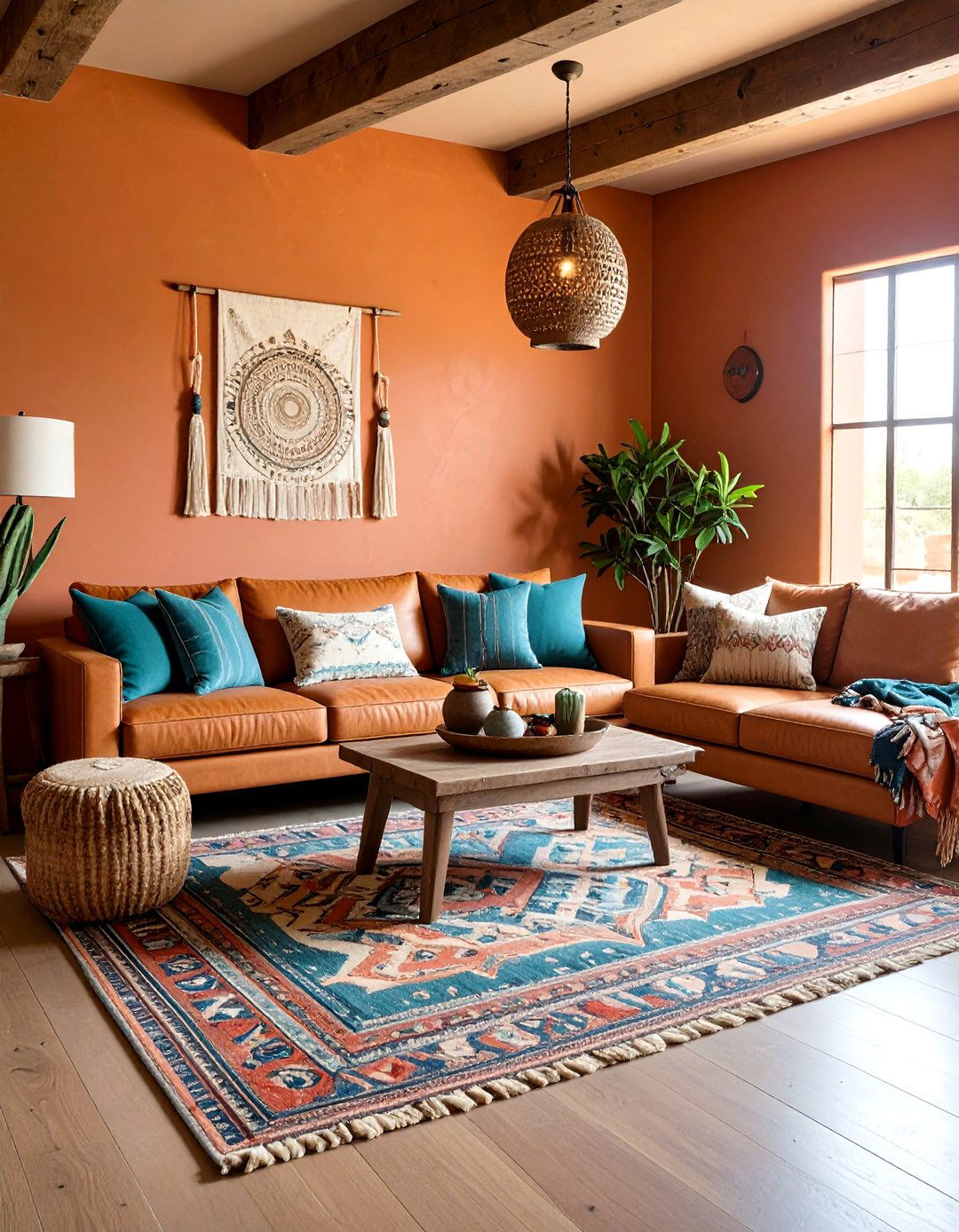
Embrace a foundation of warm, earthy hues—terracotta, ochre, sand, and muted sage—to evoke the desert’s warmth and serenity. These colors can be applied to walls, large furniture pieces, or area rugs to establish a cohesive base. Accent tones like turquoise or coral introduce vibrant contrast reminiscent of Native American jewelry and desert blooms, adding visual interest without overwhelming the senses. Layer various shades of the same hue to achieve depth and harmony, ensuring each element complements the natural palette.
2. Textured Plastered Walls
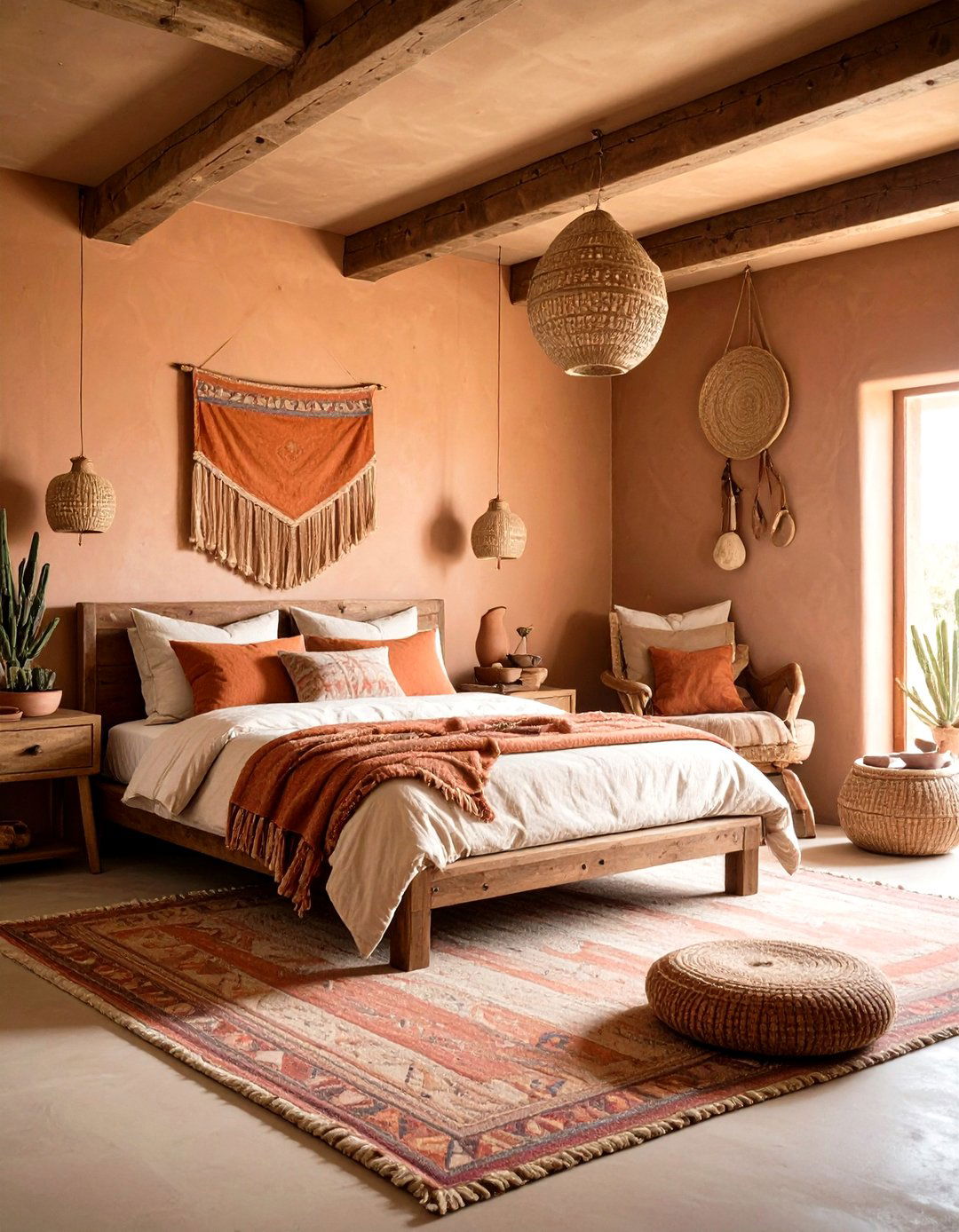
Smooth, white or light-colored plaster walls are hallmarks of Southwestern interiors, providing a neutral backdrop that highlights other décor elements. Tadelakt or limewash finishes create a subtle sheen and organic texture, reflecting light softly across the room. The slightly uneven surface adds handcrafted charm and pairs beautifully with rustic wood beams and stone accents, reinforcing the region’s adobe architectural roots.
3. Exposed Wooden Beams (Vigas)
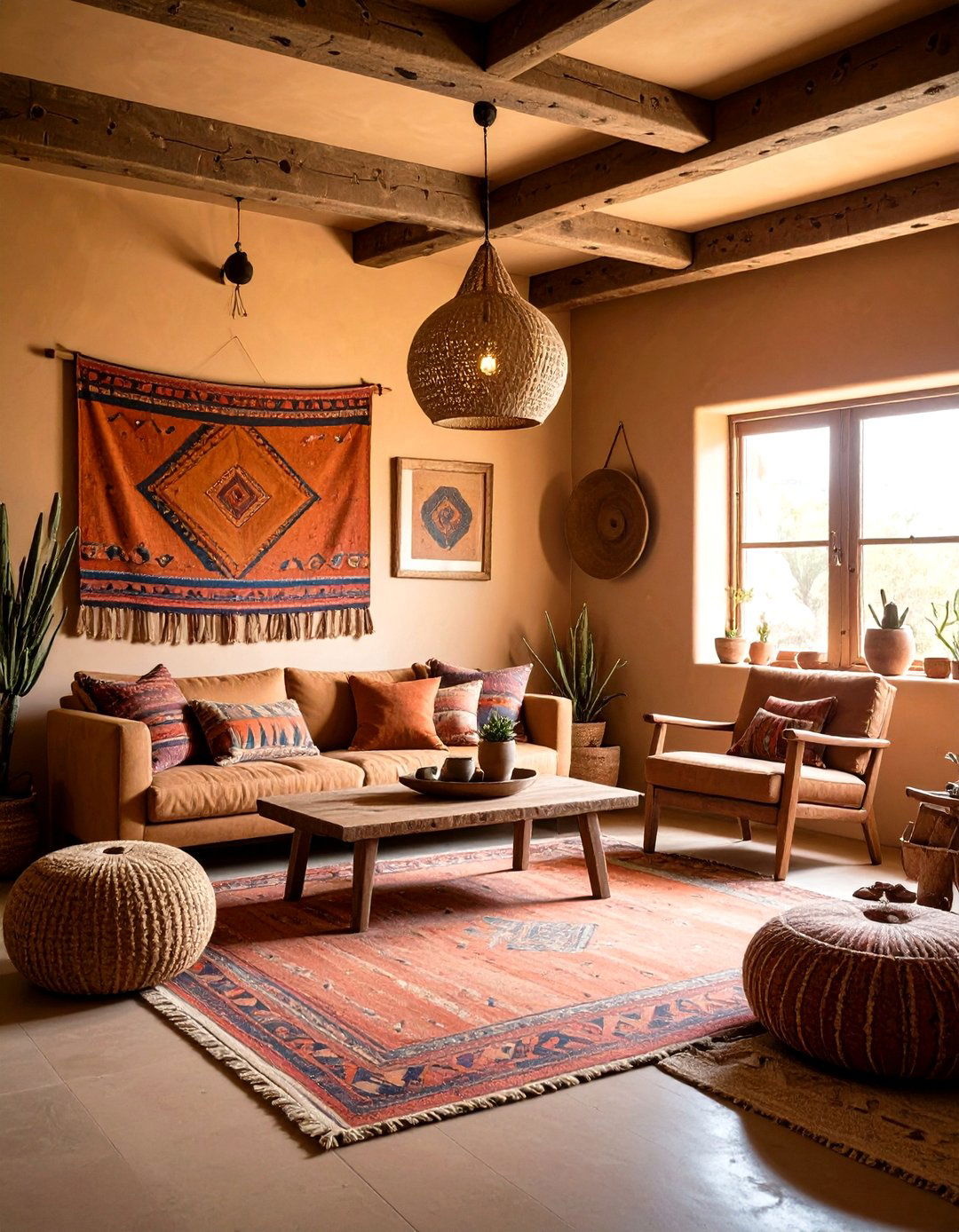
Exposed vigas—rounded wooden beams projecting from the ceiling—are architectural features borrowed from Pueblo and Spanish Colonial styles. These beams introduce warmth and rustic character, drawing the eye upward and emphasizing ceiling height. Authentic vigas are typically rough-hewn pine or fir, but reclaimed wood beams can also achieve an aged patina. Whether structural or decorative, vigas anchor the room’s design and reinforce the Southwestern theme.
4. Saltillo Tile Flooring
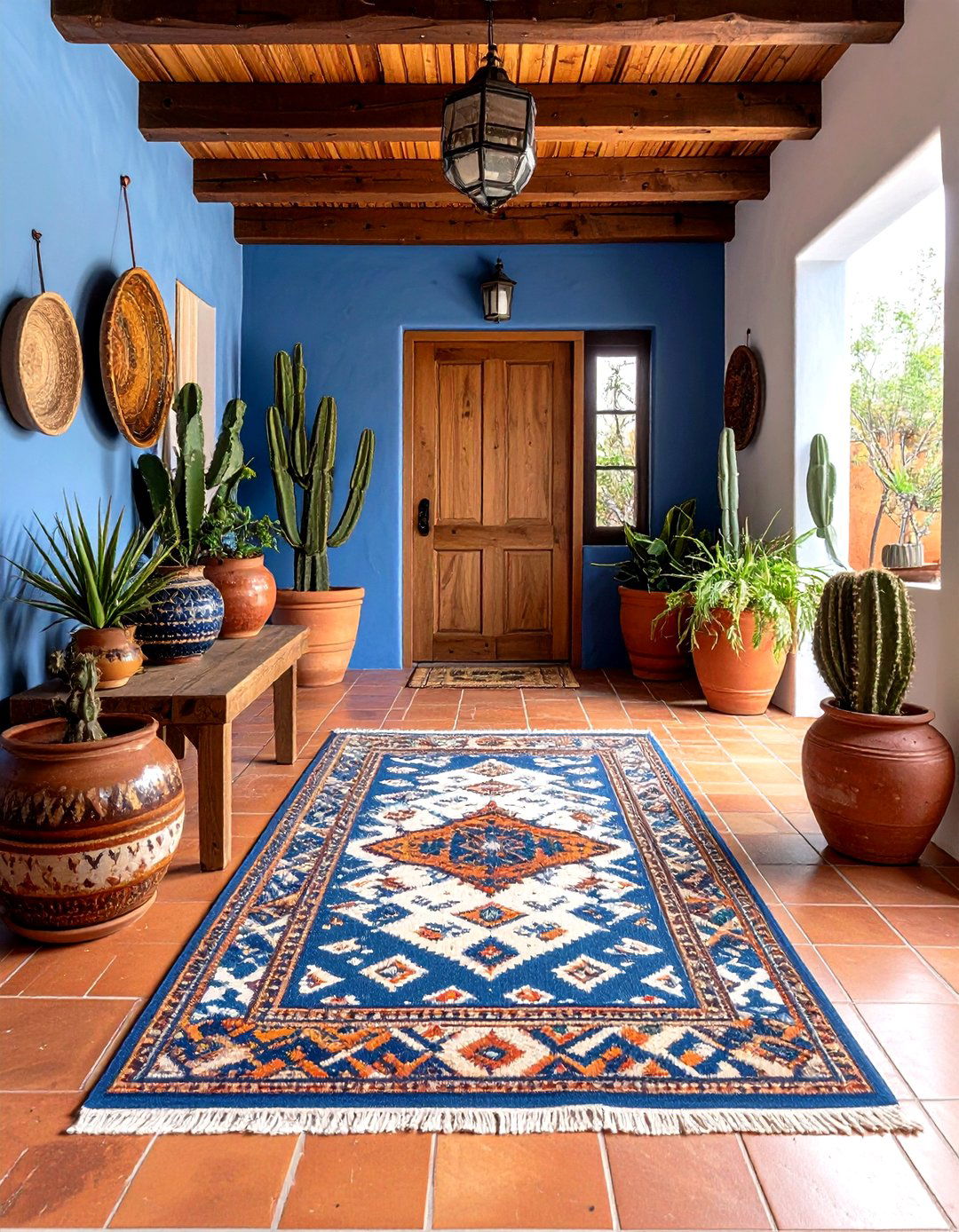
Saltillo tiles—unglazed, terracotta-colored clay tiles—offer an authentic Southwestern floor covering that’s both durable and beautiful. Their irregular shapes and warm tones impart an artisanal look, suitable for high-traffic areas like entryways or kitchens. Pair them with area rugs featuring Southwestern patterns to soften the floor and add comfort underfoot. Regular sealing protects against stains and moisture, ensuring longevity.
5. Natural Stone Accents
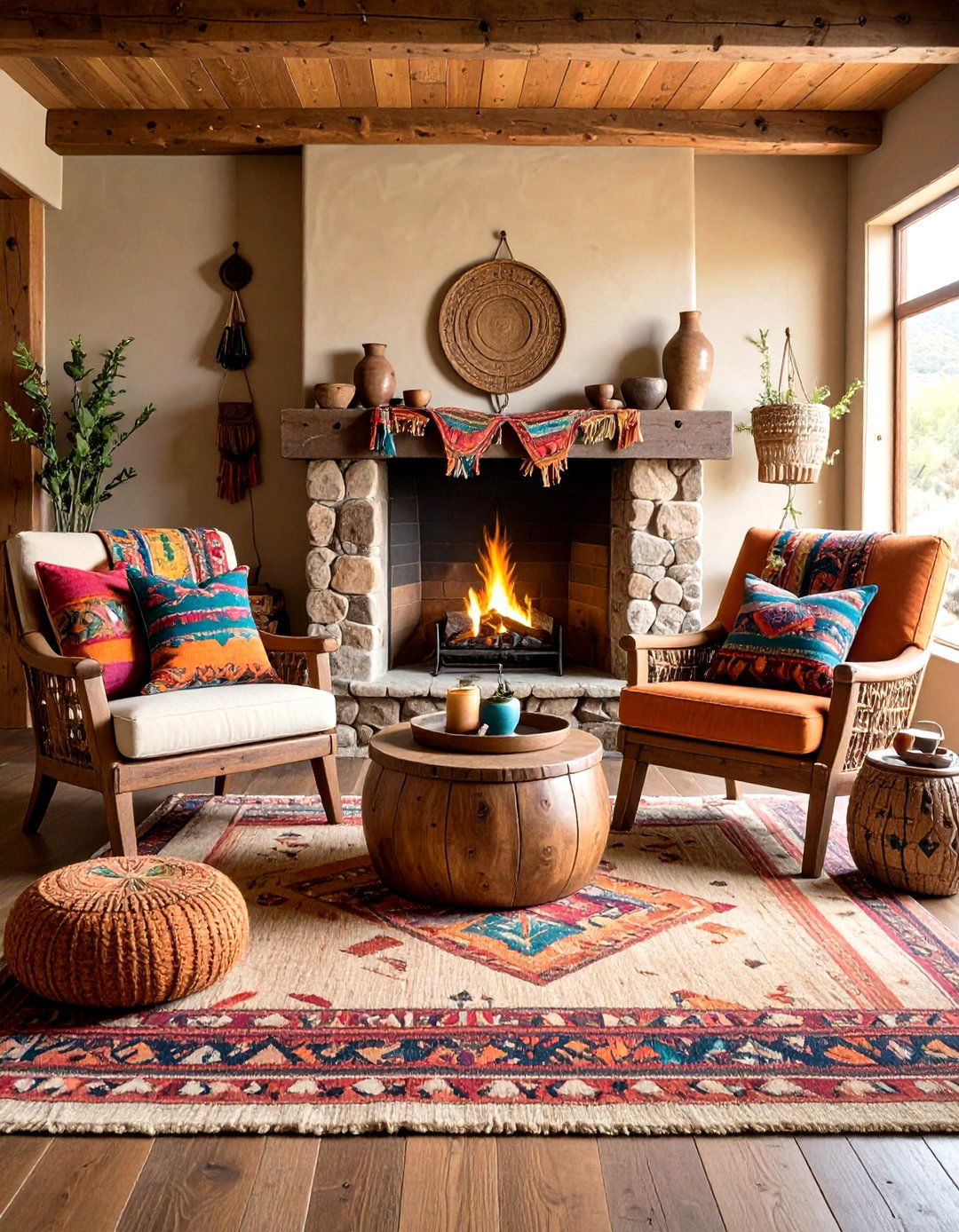
Integrate stone—flagstone, slate, or river rock—into fireplaces, accent walls, or flooring transitions to echo the desert’s rugged terrain. A stone-clad fireplace becomes a focal point, imparting warmth and grounding the space. Smaller applications, such as a stone backsplash in the kitchen or bathroom, offer subtle texture and connect indoor spaces to the natural landscape outside.
6. Handwoven Textiles
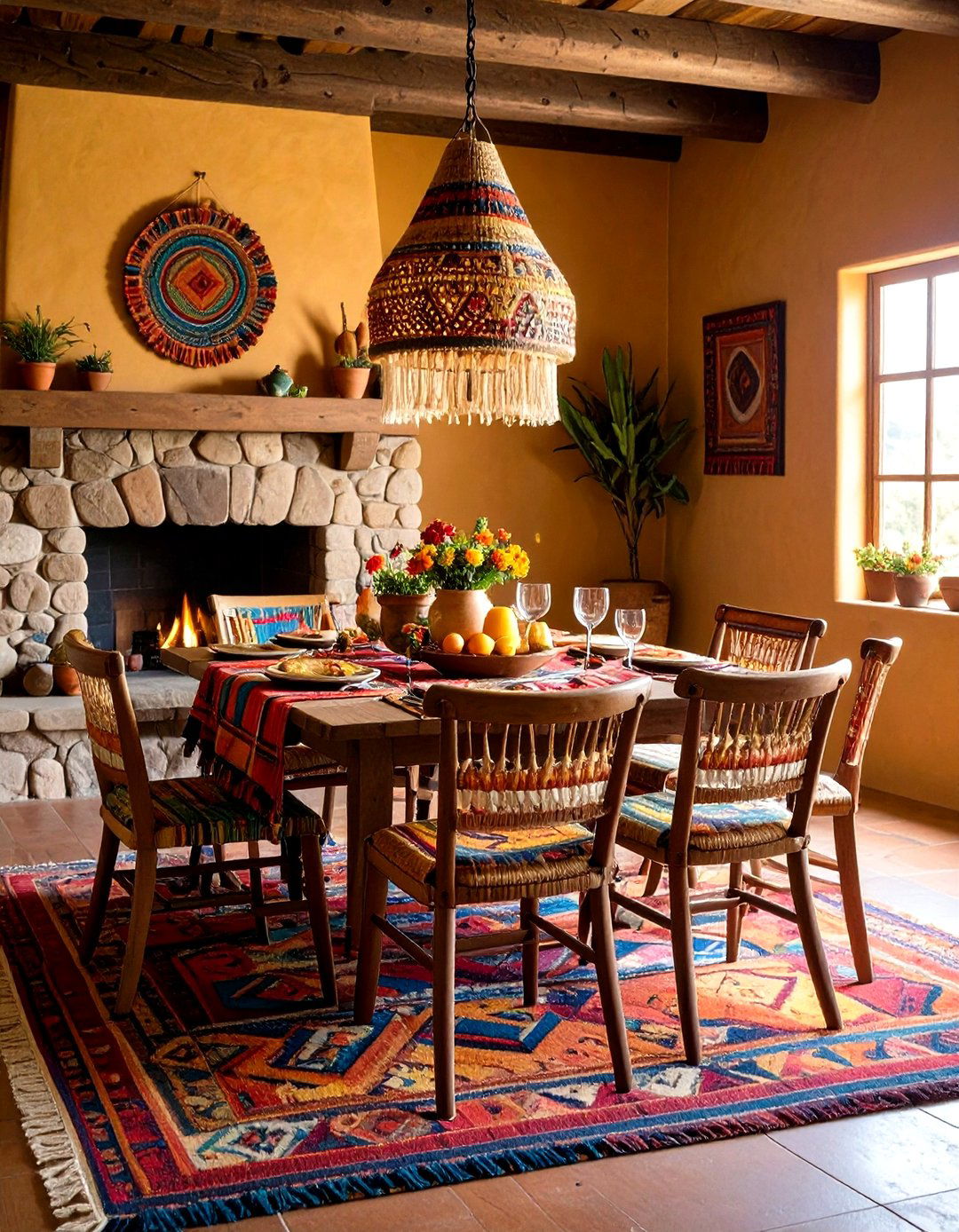
Handwoven rugs, blankets, and tapestries featuring Navajo, Zapotec, or Tribal patterns are essential in Southwestern décor. Bold geometric motifs in reds, blacks, and creams provide visual interest and cultural authenticity. Use these textiles as area rugs, wall hangings, or throw blankets to introduce color, pattern, and artisanal craftsmanship, fostering a cozy and personalized atmosphere.
7. Leather Furniture and Accents
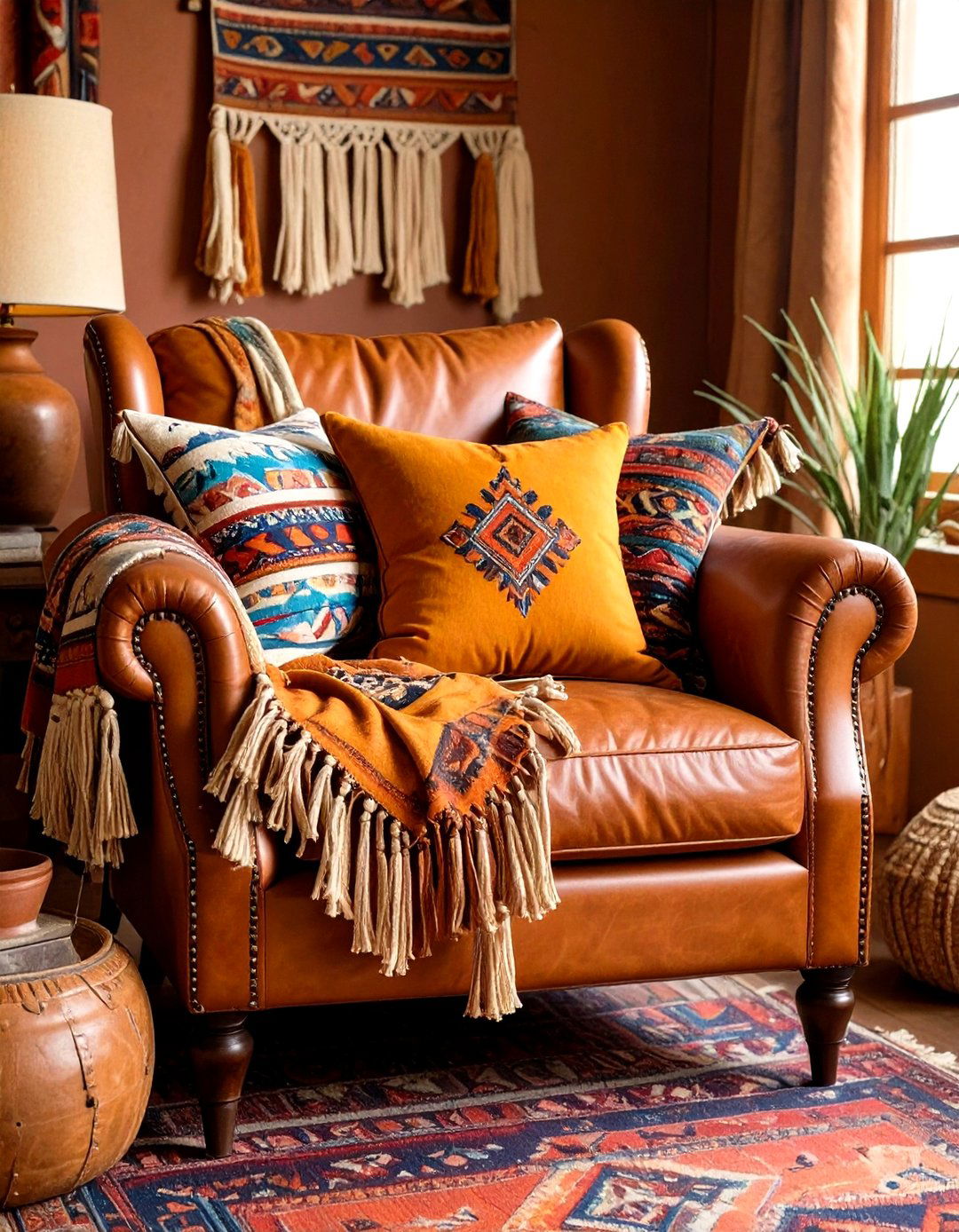
Leather—especially in warm cognac or chocolate tones—adds both luxury and durability. A well-worn leather sofa or armchair introduces smooth texture and ages beautifully over time. Complement leather seating with woven or fringed pillows and throws to soften the look and integrate textile patterns, balancing rugged materials with soft comforts.
8. Cowhide Rugs
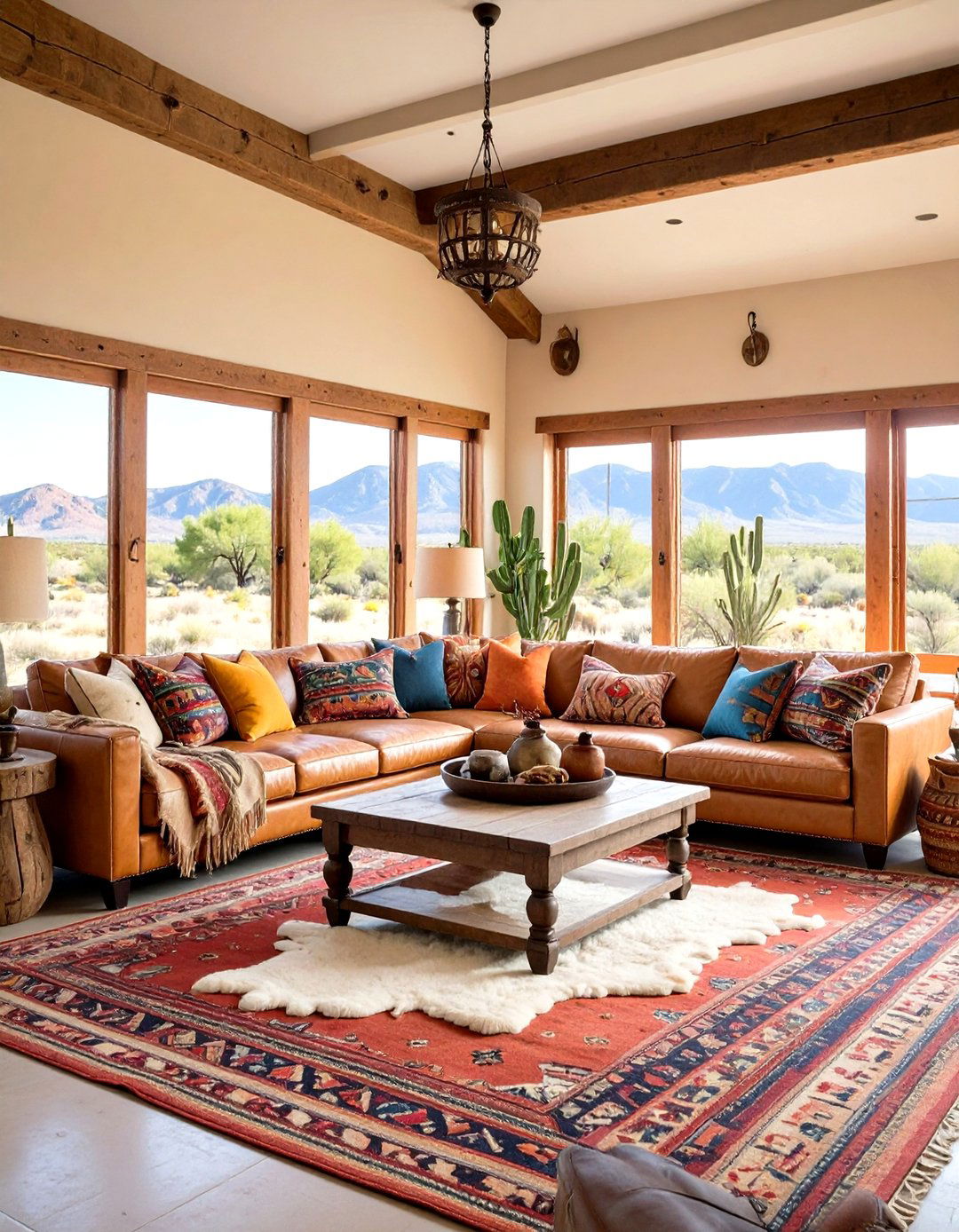
Cowhide rugs are versatile floor coverings that add organic shape and tactile interest. Their natural patterns range from stark black-and-white to richer brown hues, blending seamlessly with earthy palettes. Place them under coffee tables or beside beds to introduce a layer of texture without overpowering patterned textiles.
9. Woven Baskets and Storage
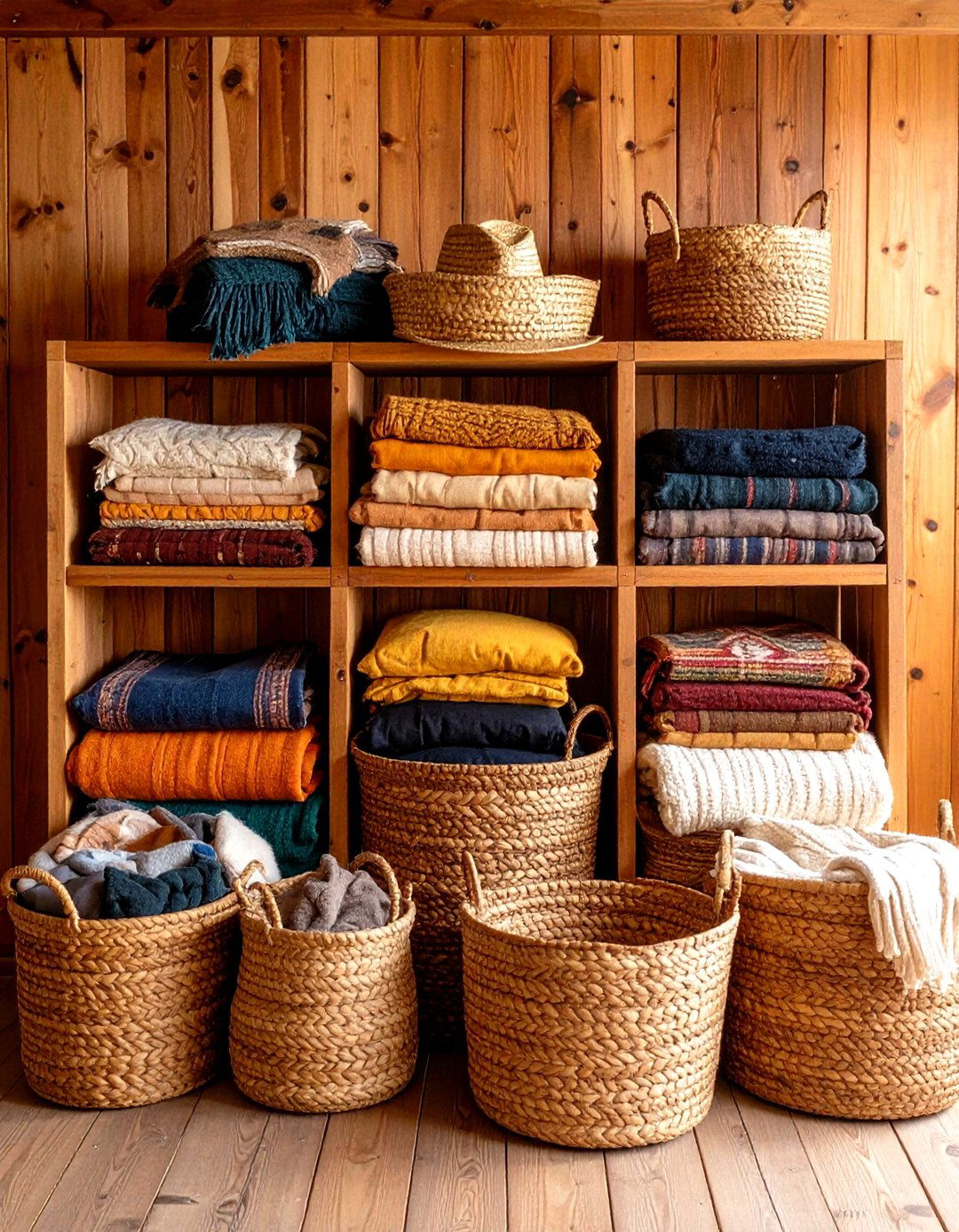
Handcrafted woven baskets—made from seagrass, rattan, or reeds—provide functional storage and decorative flair. Use them to corral throws, magazines, or household items, keeping spaces organized while reinforcing natural, artisanal themes. Cluster baskets of varying sizes for visual interest and easy accessibility.
10. Iron and Metalwork

Wrought-iron accents—lighting fixtures, curtain rods, or furniture legs—bring an industrial yet artisanal edge. Hand-forged lanterns or sconces with scrollwork cast intricate shadows and add Old World charm. Pair iron elements with softer materials like wood and textiles to achieve balanced contrast.
11. Southwestern Pottery
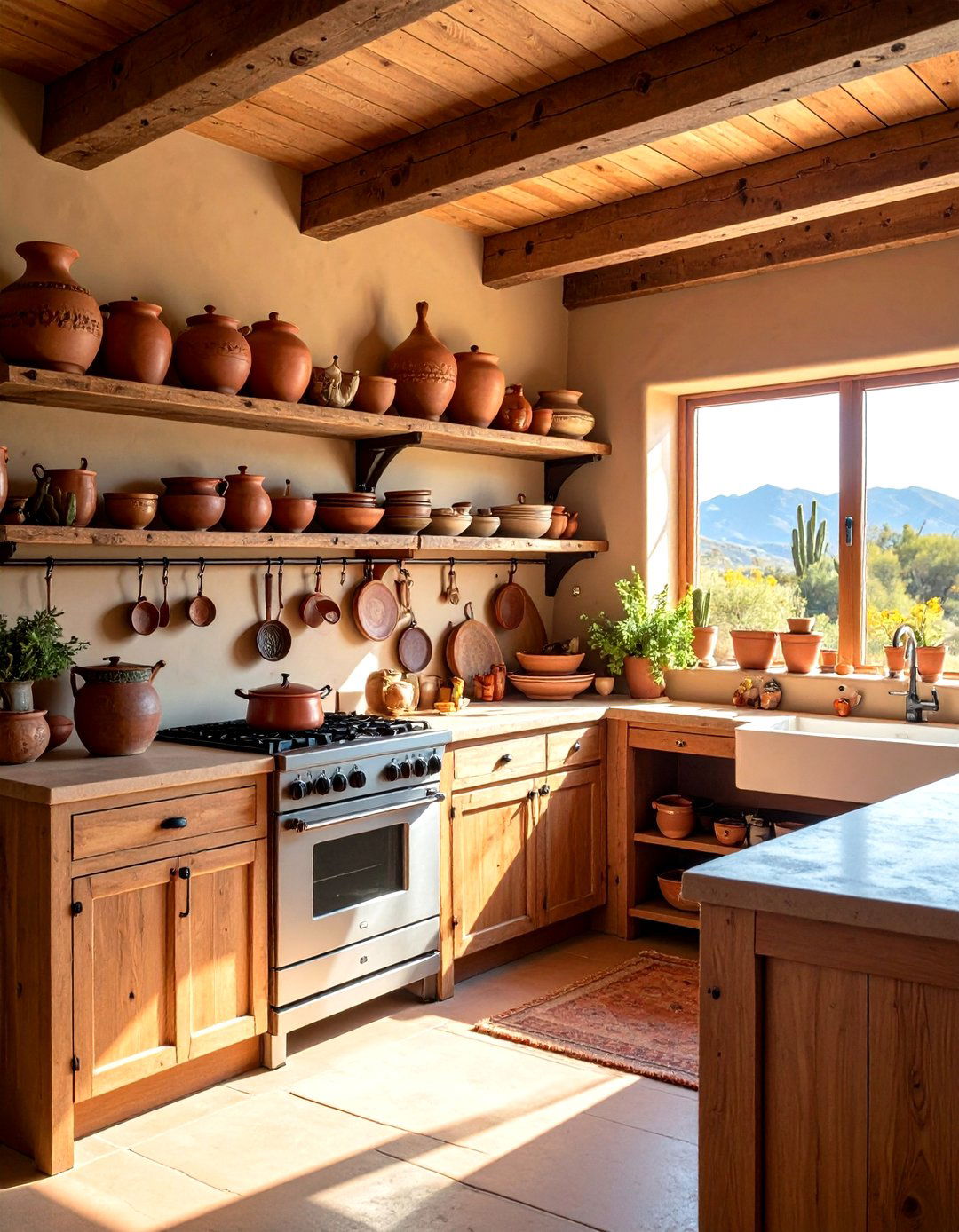
Handmade clay pottery—pitchers, vases, or decorative bowls—serves as both functional and ornamental pieces. Traditional black-on-black Mesa ceramics or terracotta-colored vessels reflect Indigenous craftsmanship and add sculptural interest. Display pottery on open shelving, mantels, or dining tables to celebrate artisan work.
12. Bold Artwork and Murals
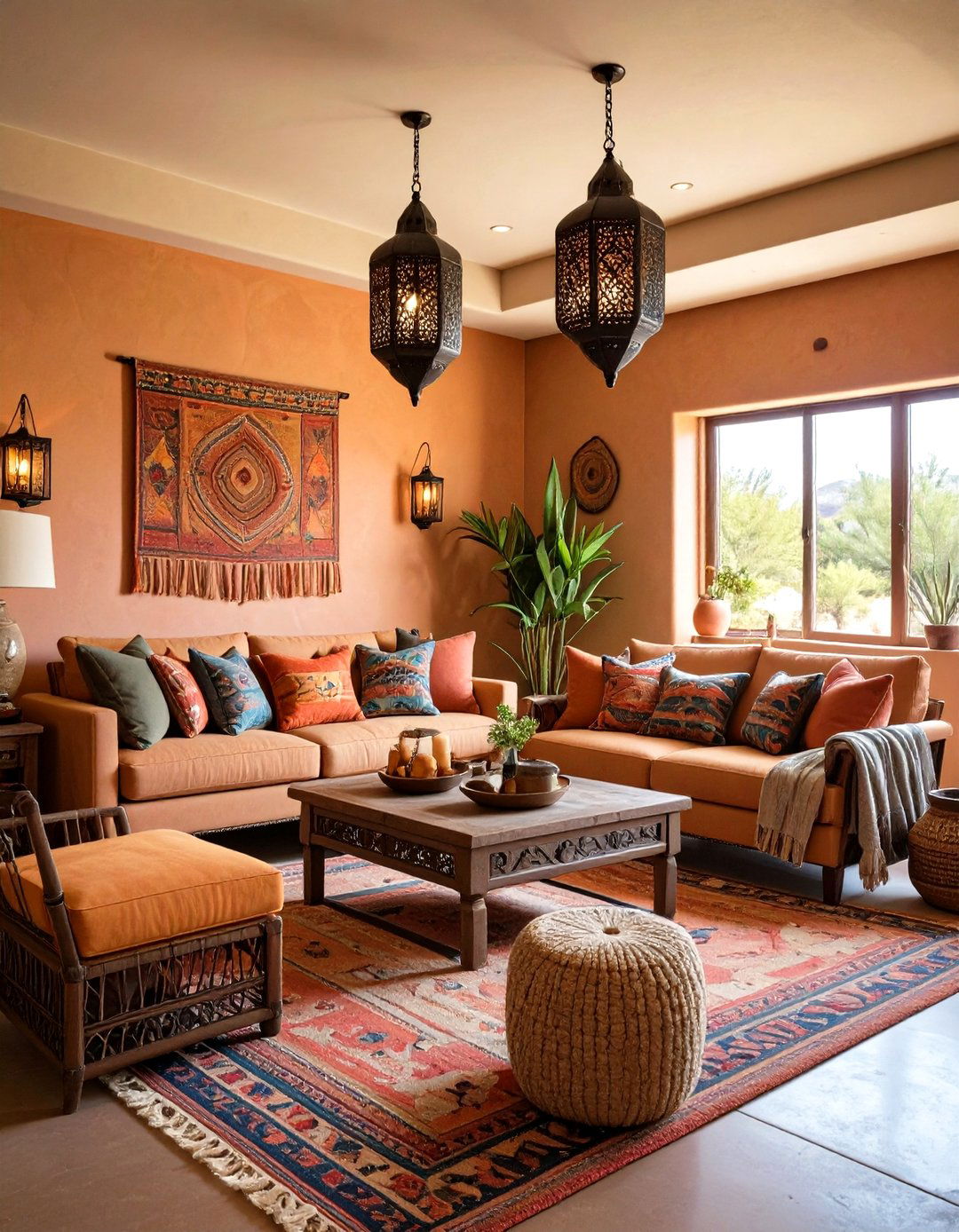
Large-scale artwork—landscape photography of desert scenes, abstract paintings in sunset hues, or hand-painted murals—anchors walls and sets the room’s tone. Murals depicting desert vistas or stylized cactus motifs create immersive focal points. Opt for frames in distressed wood or metal to complement surrounding textures.
13. Layered Lighting
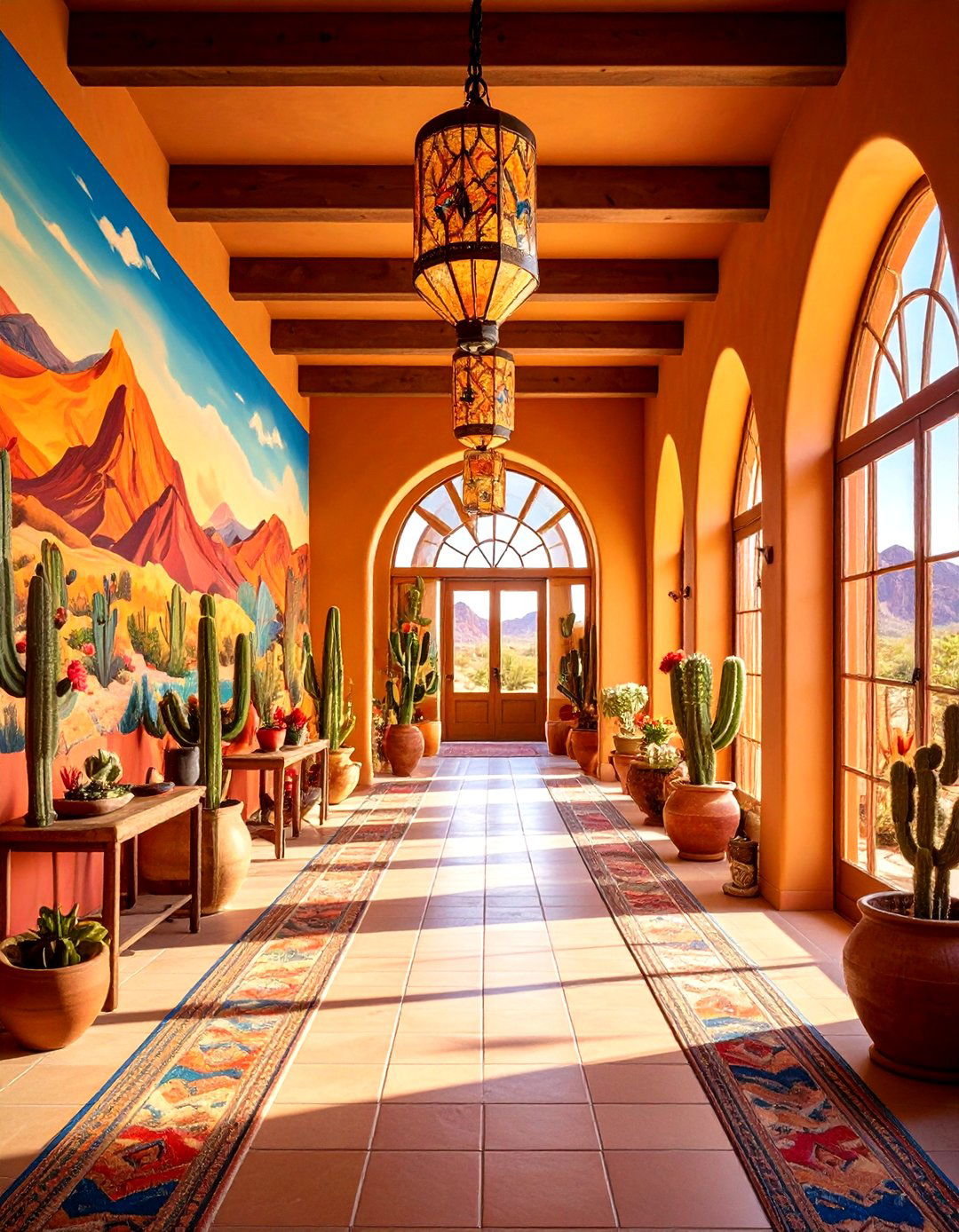
Layer lighting with ambient (recessed or track lighting), task (reading lamps), and accent (wall sconces, lanterns) to achieve depth and versatility. Iron or ceramic lamps with woven shades diffuse warm light, enhancing the room’s cozy, inviting feel. Dimmer switches allow mood adjustments, especially important for evening gatherings.
14. Indoor Greenery
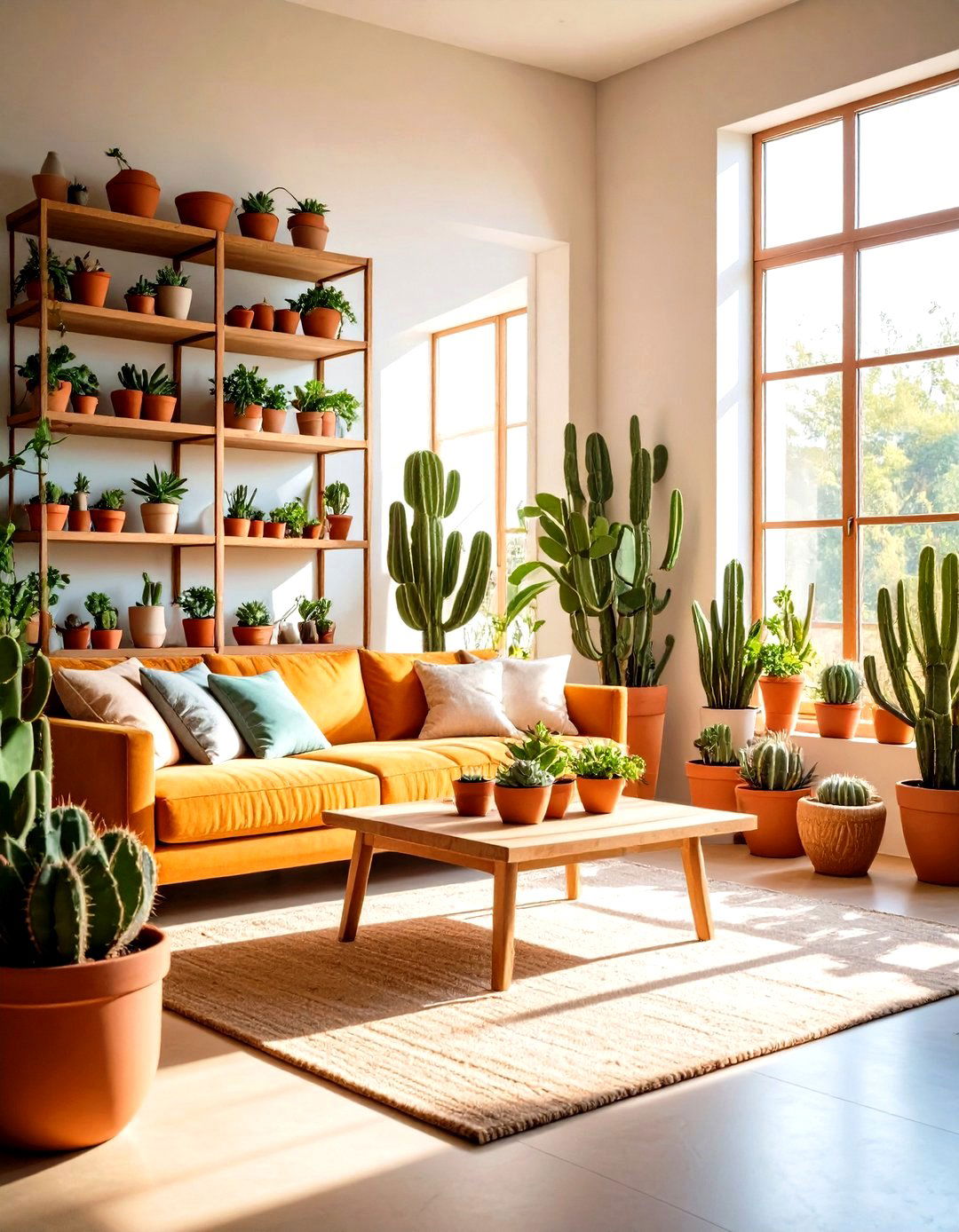
Introduce succulents, cacti, and other drought-tolerant plants to bring life and a sense of place indoors. Terracotta pots or hammered-metal planters complement the earthy palette. Group plants at varying heights—on shelves, side tables, or floor stands—to mimic natural desert clustering.
15. Pattern Layering
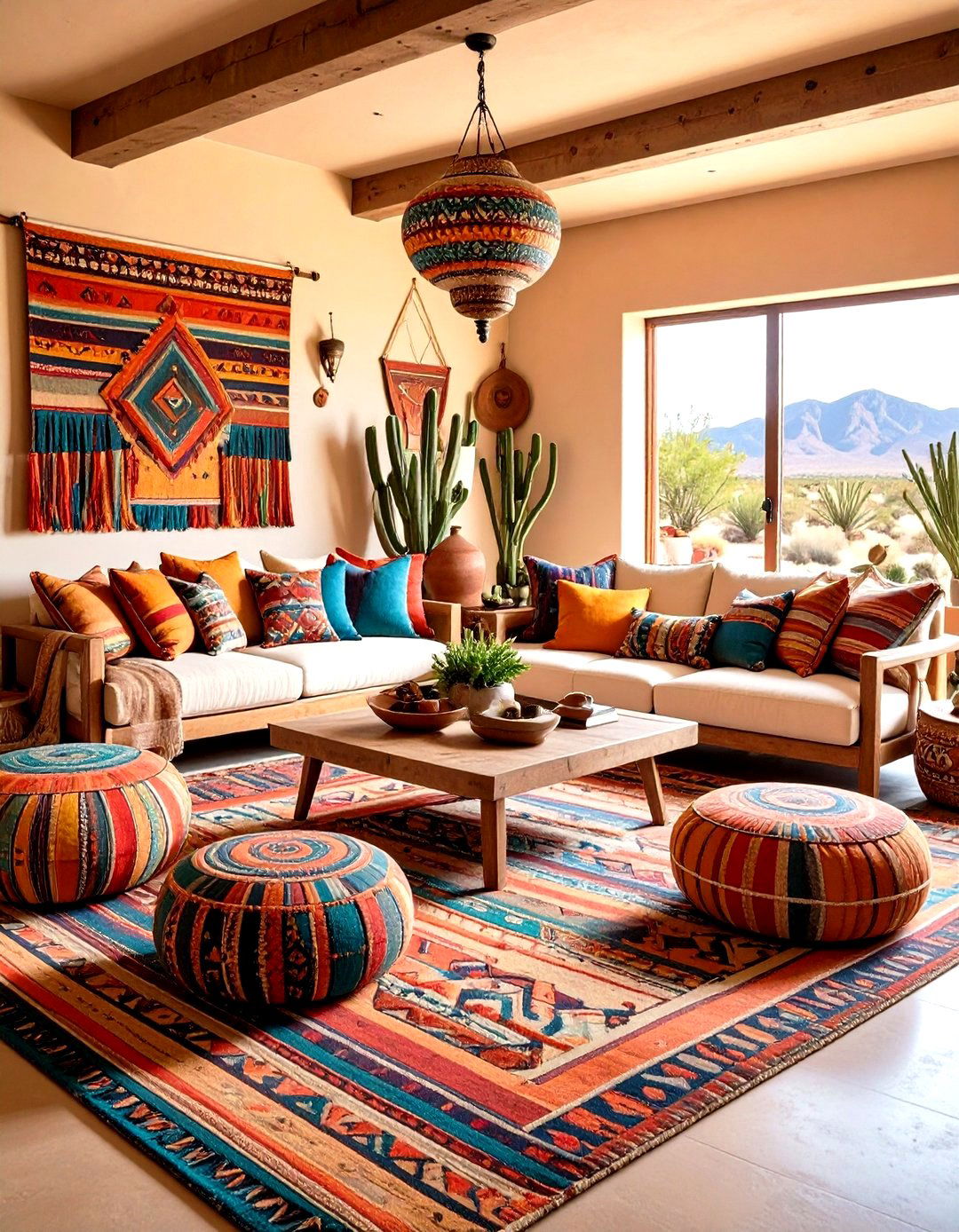
Combine multiple patterns—geometric, striped, and tribal—across rugs, pillows, and upholstery for a dynamic yet harmonious look. Stick to a unified color palette (earth tones with accent hues) to prevent visual chaos. Vary pattern scale: large motifs on rugs, medium on throw pillows, small on accent fabrics.
16. Rustic Wood Furniture
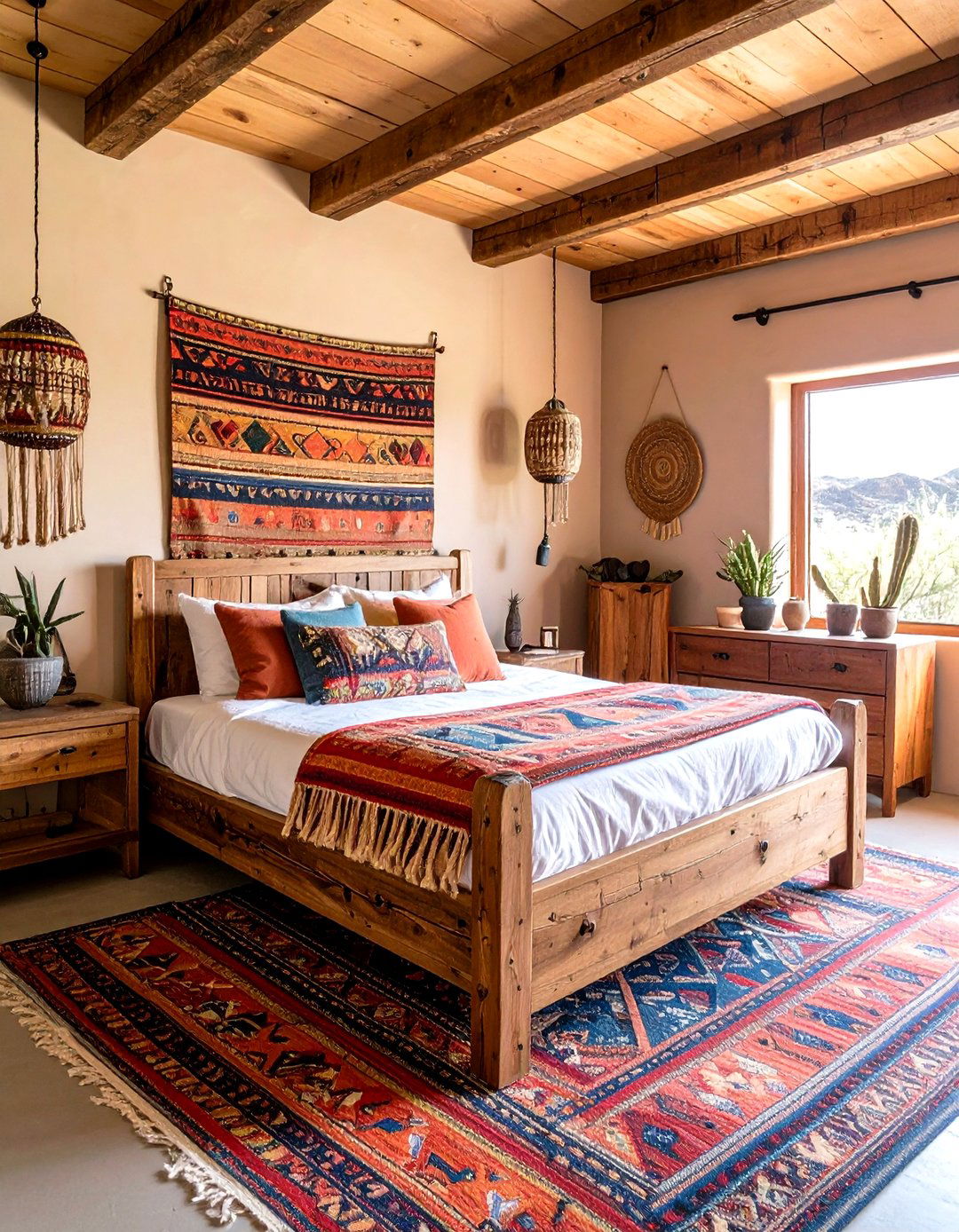
Solid wood furniture—tables, benches, or bed frames—should showcase natural grain and imperfections. Distressed or reclaimed wood adds history and character. Pair with upholstered seating or woven textiles for comfort, ensuring pieces remain functional and inviting.
17. Adobe-Inspired Fireplaces
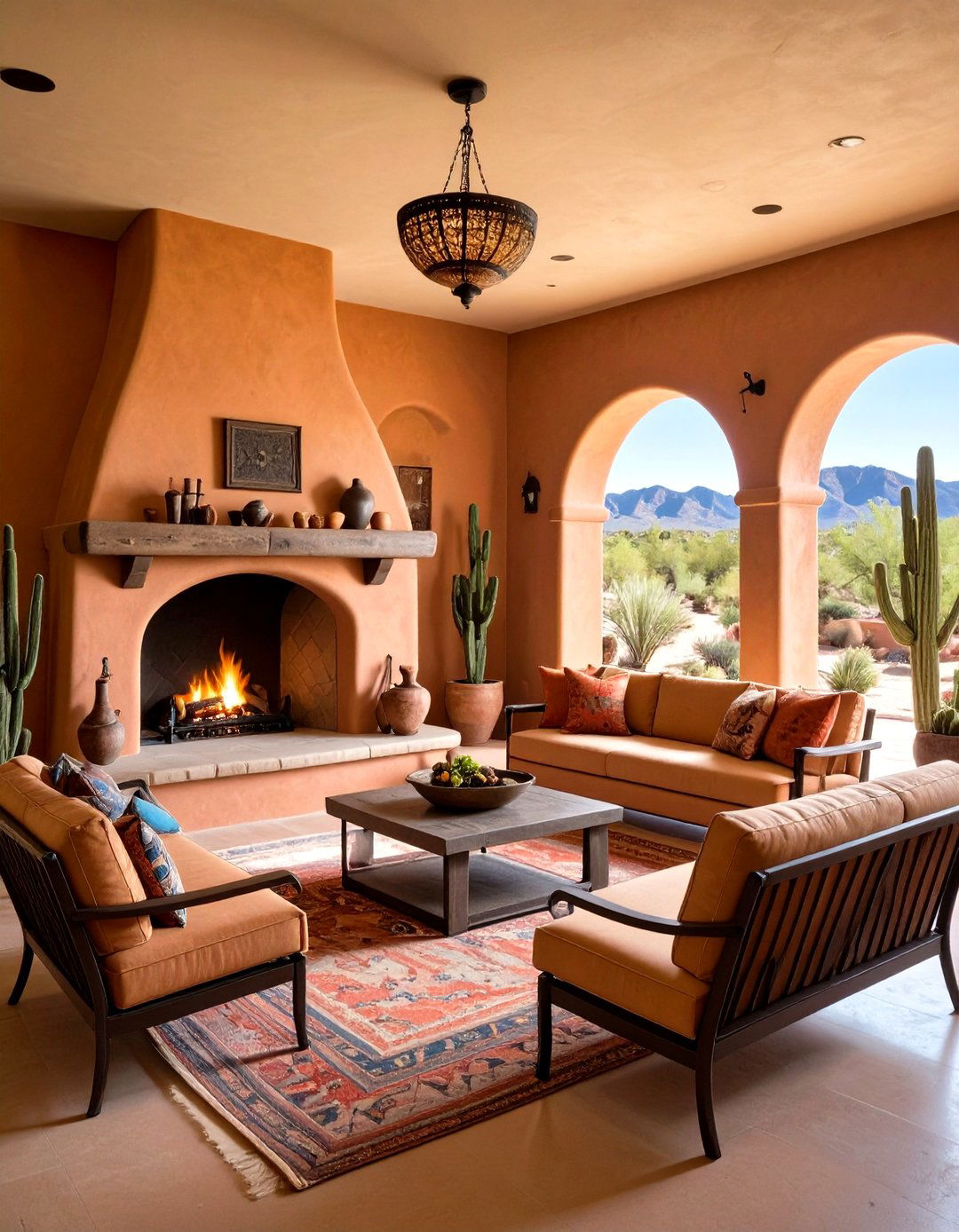
Rounded, stuccoed fireplaces with built-in benches (kiva style) are quintessential Southwestern features. Their smooth, organic forms promote communal gathering around warmth. Accent with iron tools and hand-carved mantels to enhance authenticity.
18. Decorative Horns and Photography

Decorate walls with ram or longhorn skulls—real or sculptural—for a ranch-inspired touch. Alternatively, framed horse or desert wildlife photography brings movement and life. Balance edgy décor with soft textiles to maintain warmth.
19. Courtyard and Patio Integration

Extend the indoor aesthetic outdoors by designing a courtyard or patio with flagstone flooring, low stucco walls, and wrought-iron furniture. Outdoor rugs in Southwestern patterns unify spaces, while string lights or lanterns create evening ambiance.
20. Desert-Inspired Accessories

Complete the look with small accessories: turquoise jewelry displayed in shadow boxes, sand-filled glass terrariums, or driftwood sculptures. These finishing touches personalize the space and reinforce the Southwest theme without overwhelming larger design elements.
Conclusion:
Southwestern interior design celebrates the harmony between rugged landscapes, Indigenous art, and colonial architecture through its earthy color schemes, layered textures, and artisanal details. Key features—plastered walls, vigas, saltillo tiles, and handwoven textiles—establish authenticity, while accents like ironwork, pottery, and live greenery enrich the look. By thoughtfully layering color, pattern, and materials, and integrating indoor-outdoor living, you can craft a space that feels both timeless and warmly inviting, reflecting the spirit of the American Southwest.




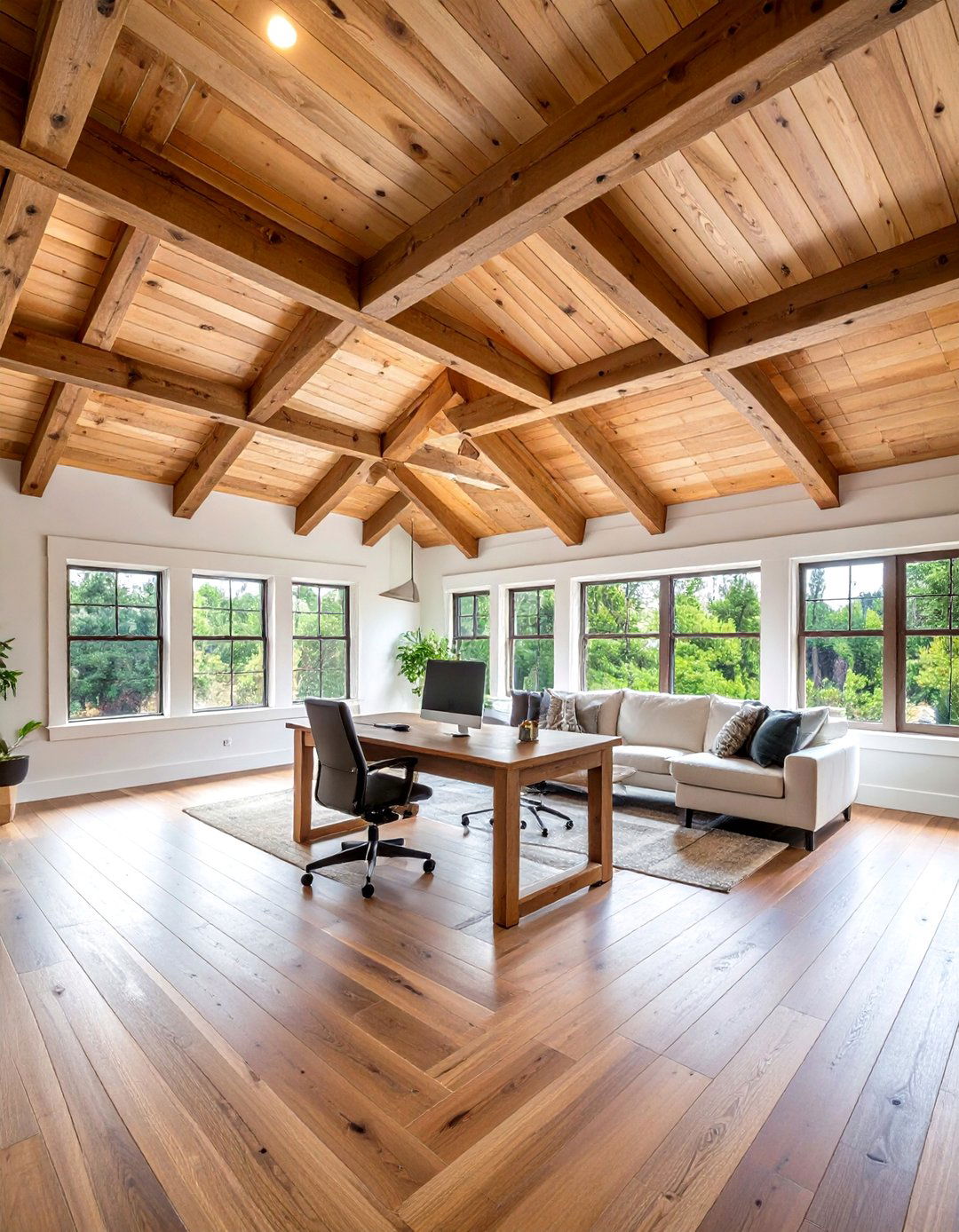


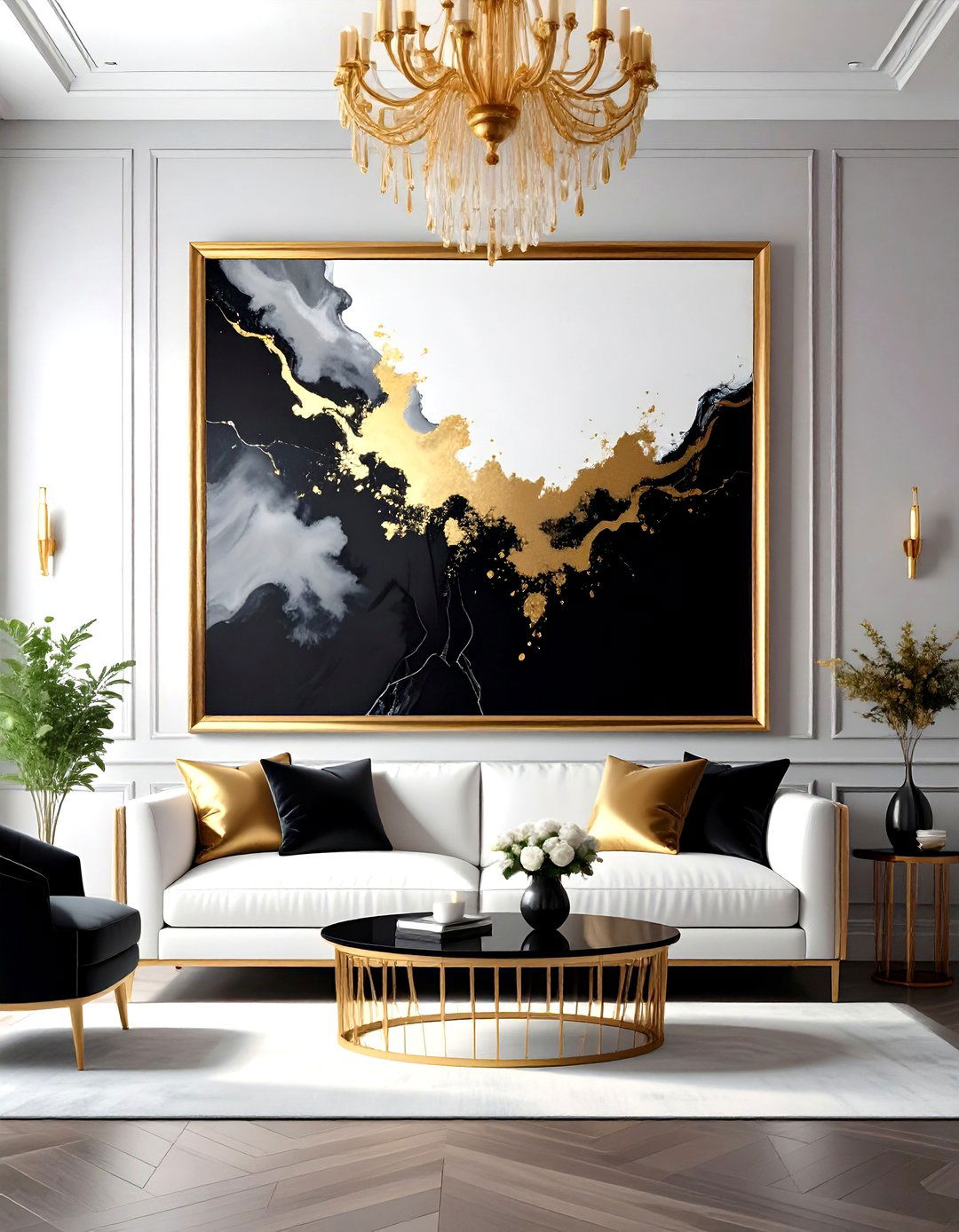
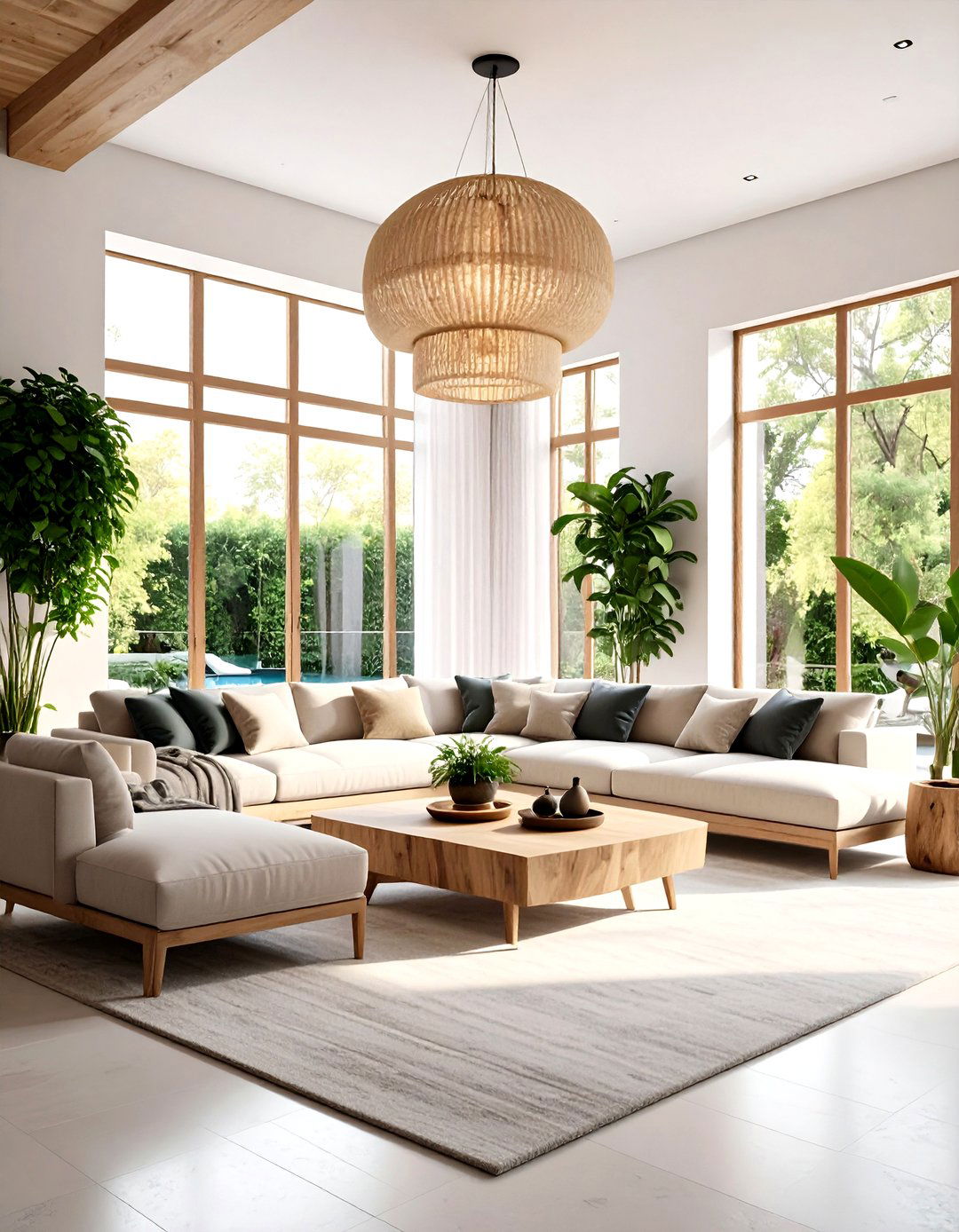
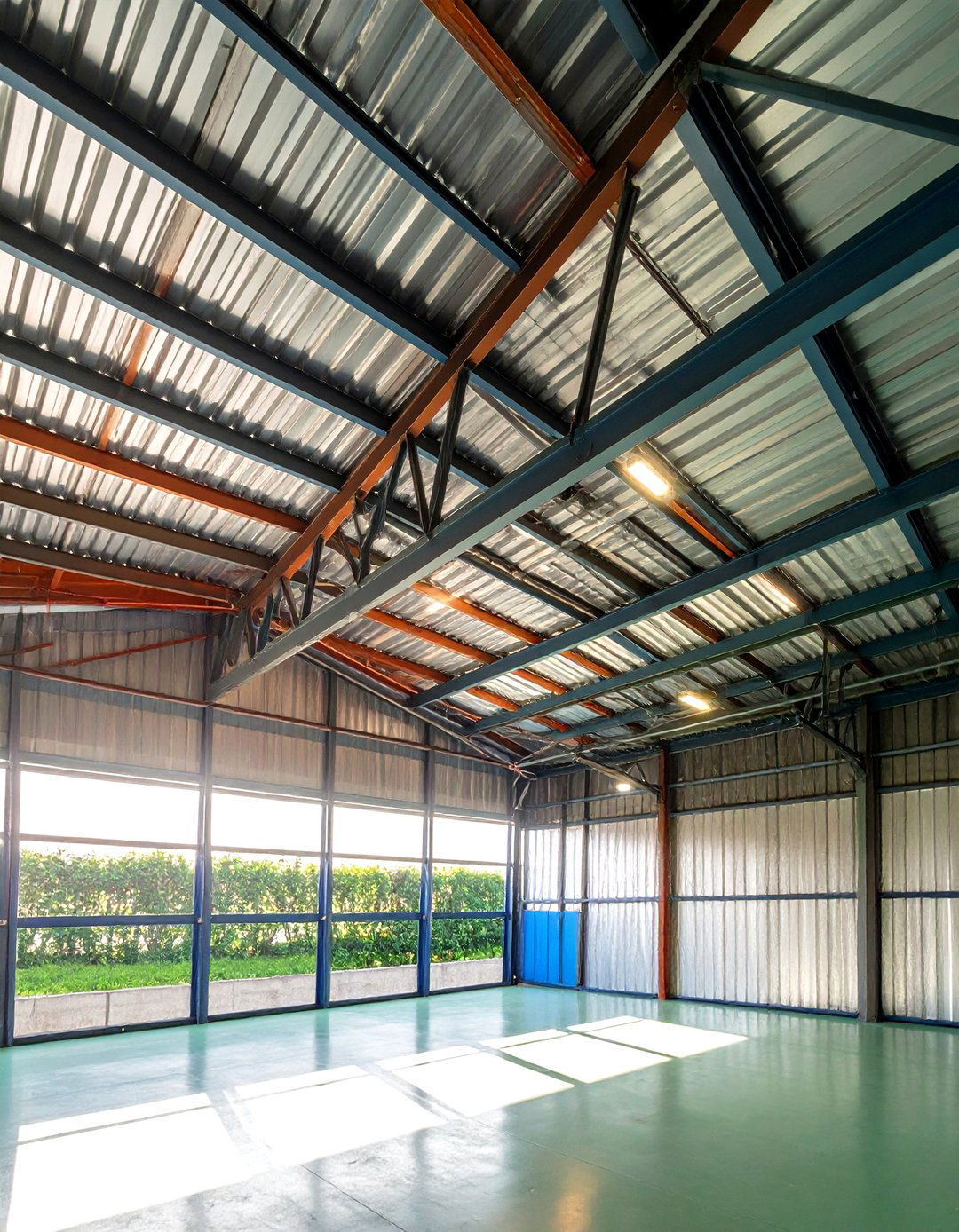
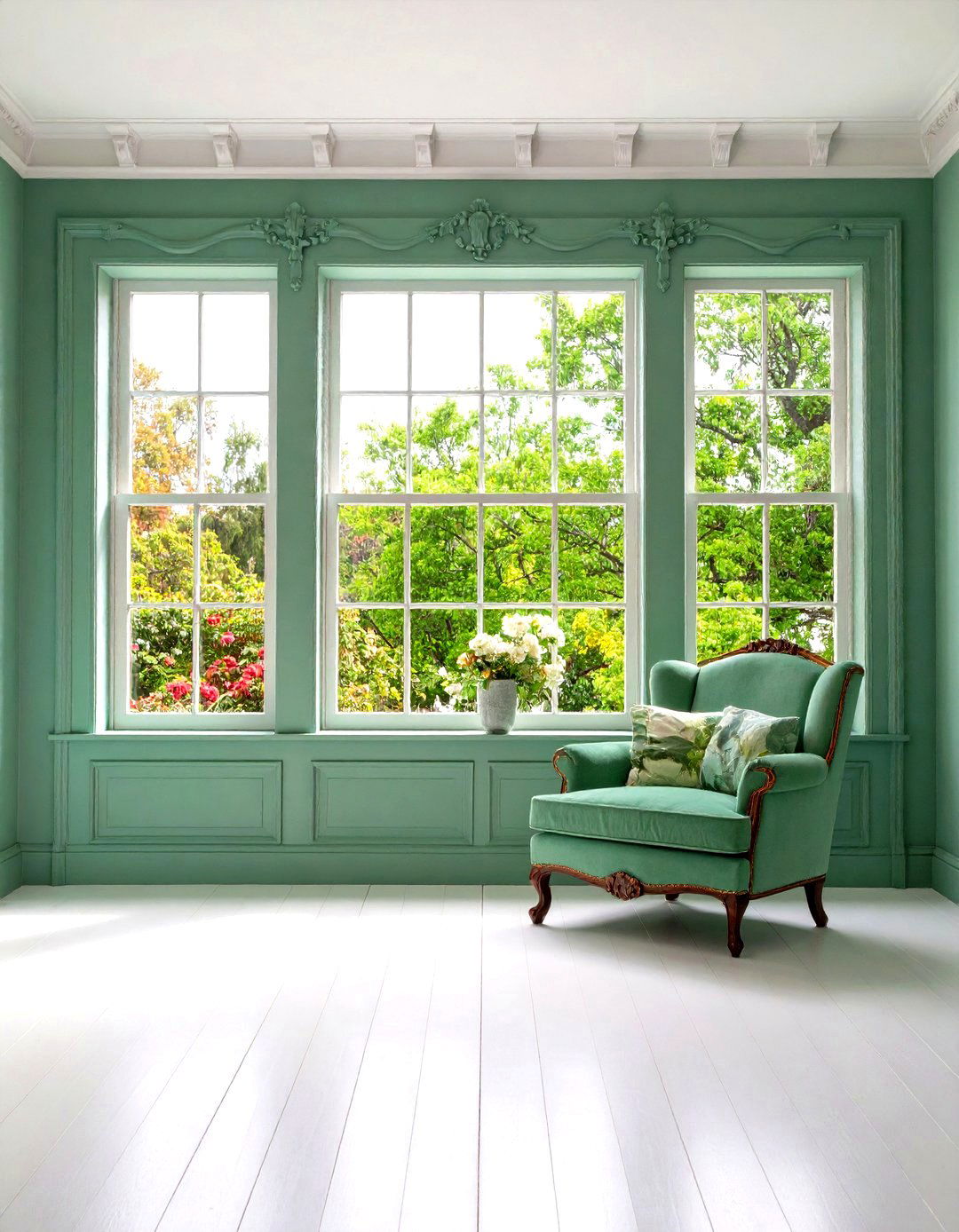
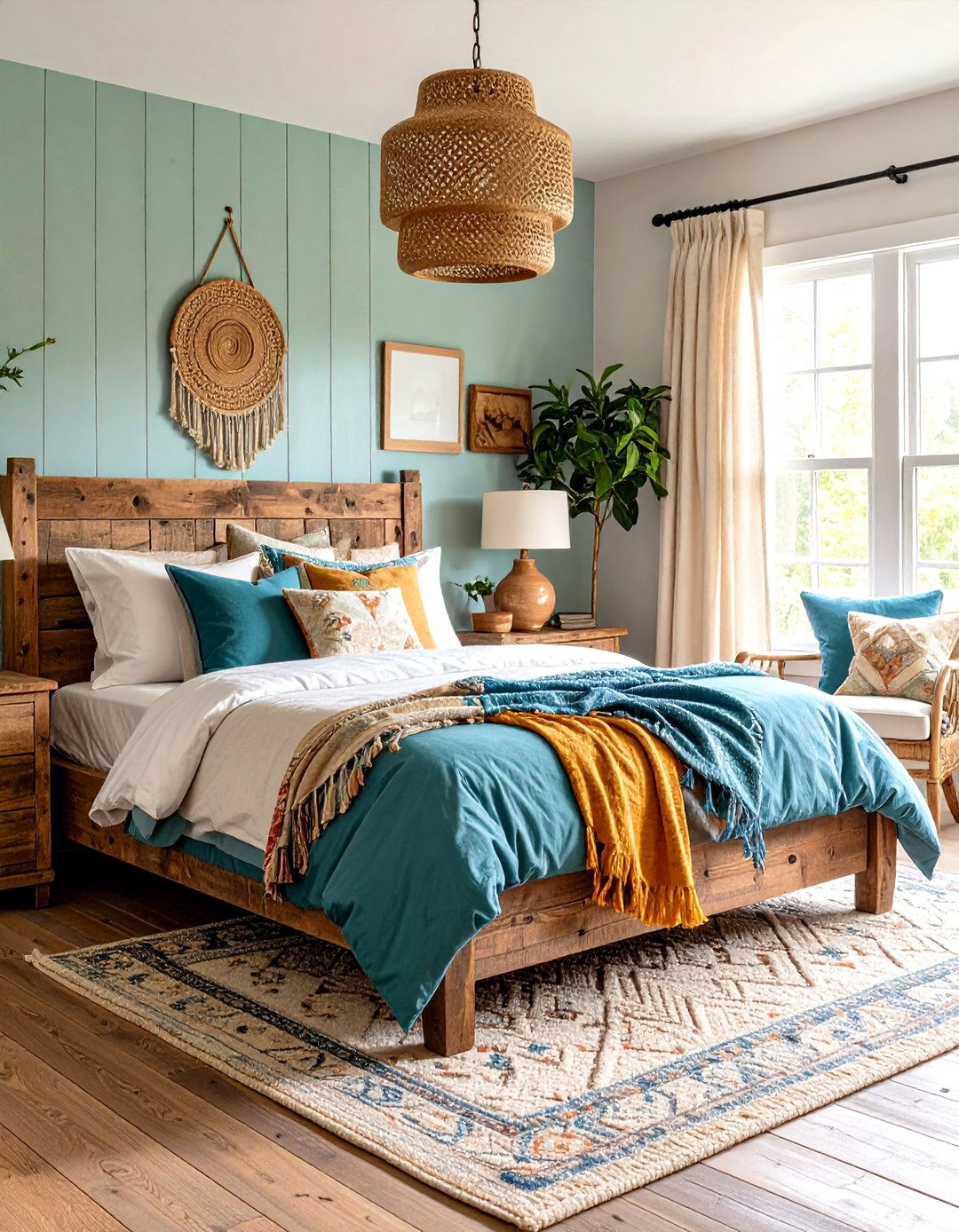
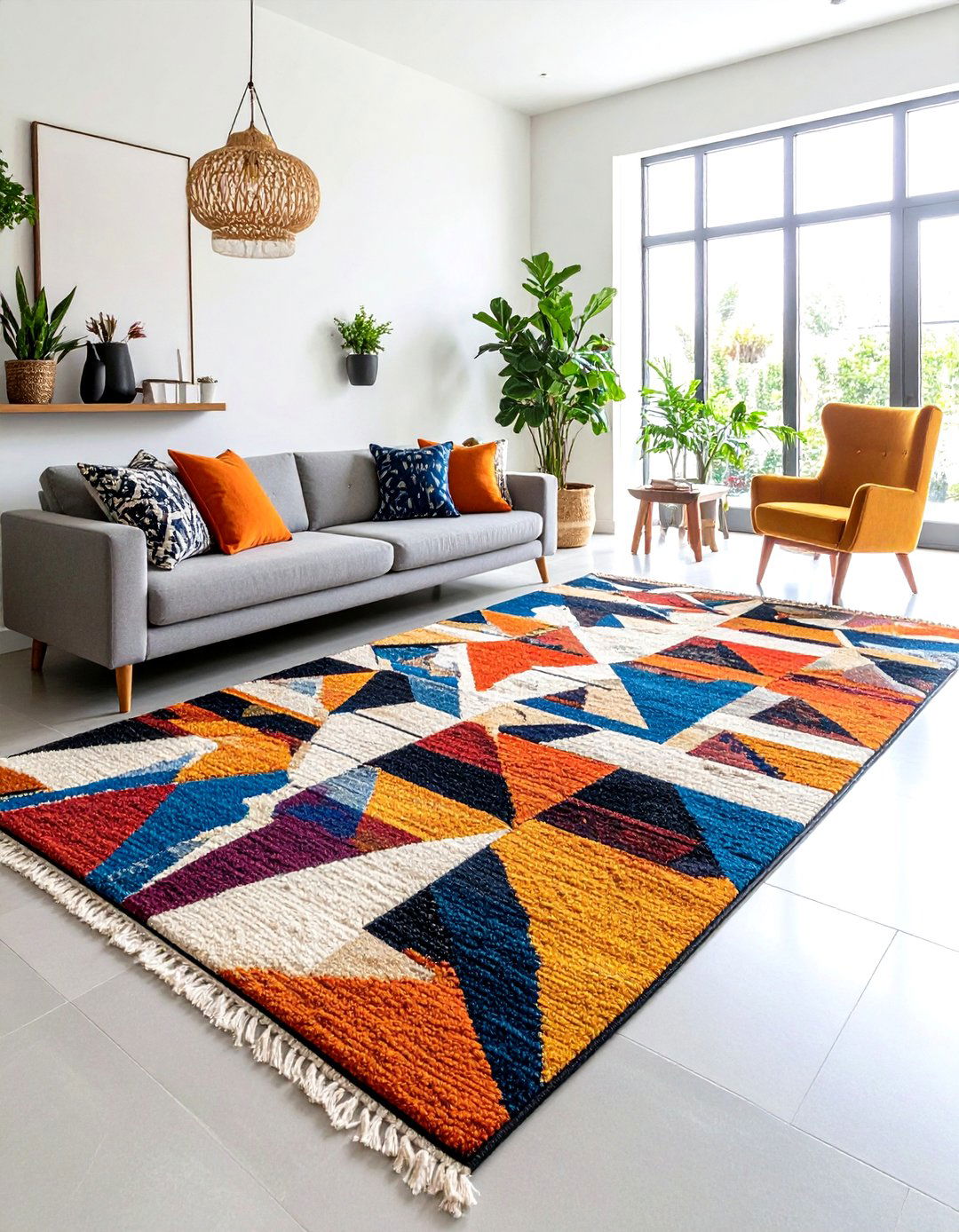
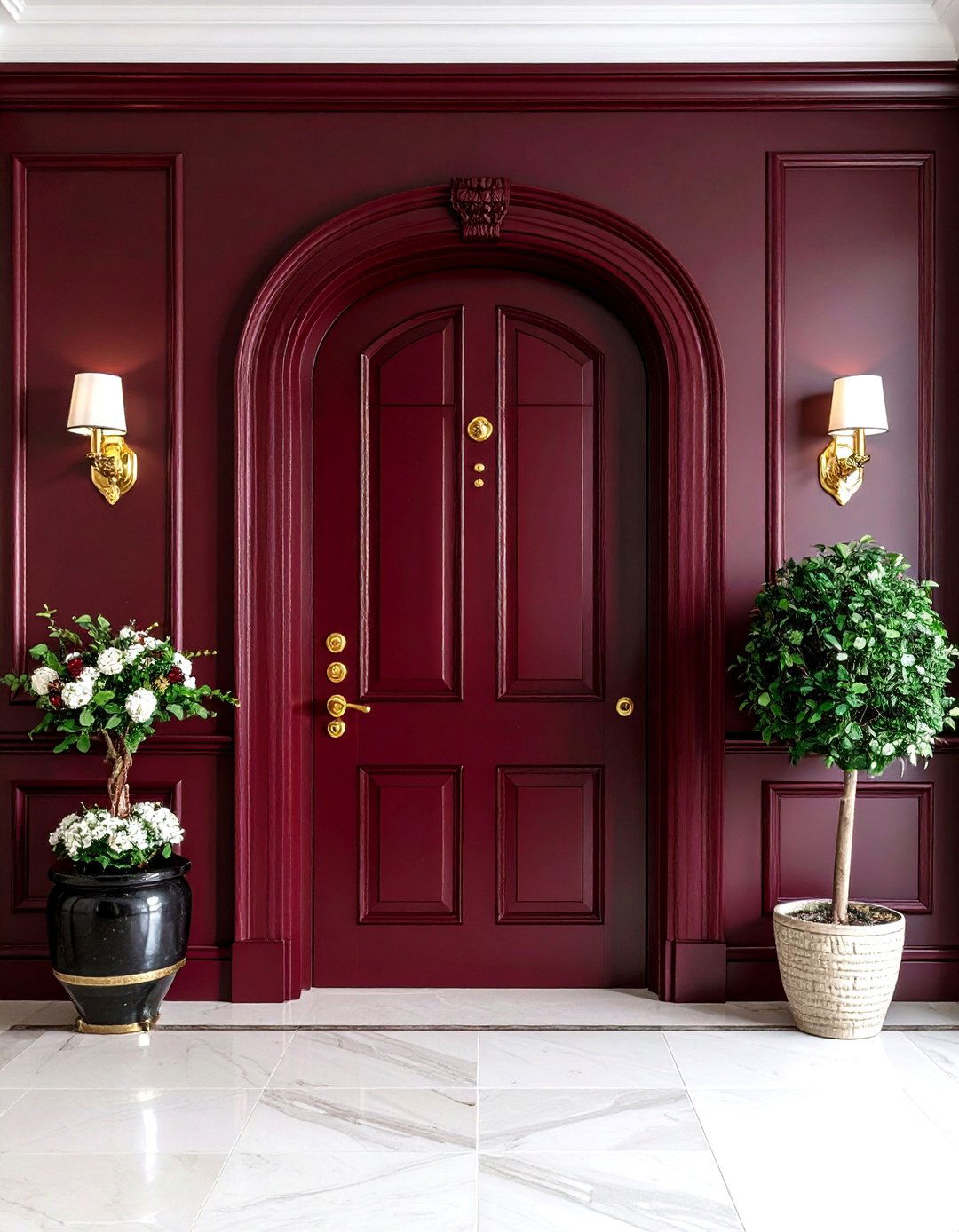
Leave a Reply